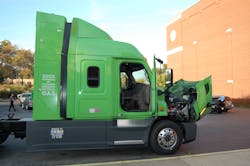At the recent CNG Industry Leaders Forum hosted by Gain Clean Fuel in St. Louis, MO, last week, several transportation veterans shared some of the insight they’ve acquired during diesel to compressed natural gas (CNG) transitions for heavy trucks.
CNG fuel quality is critical: “Fuel is the reason the transition [to natural gas] will or won’t work,” noted Robert “Bob” Carrick, manager of natural gas sales for Freightliner. “It’s got to be ‘clean’ fuel, with no oil or moisture in it.” Ken Marko, senior national manager for sustainability for Frito-Lay, noted that the impact of natural gas contaminants goes beyond reducing potential range and damaging a truck’s engine and fuel system. “We had one case where the refueling hose literally ‘froze’ to the truck due to contaminants,” he explained. “The driver in that case had to pour hot coffee over the connection to get the hose free.”
Every refueling depot is different: Billy Lawder, director of transportation engineering for Anheuser Busch, noted that the pressure, flow rates, and energy composition of natural gas sold at public refueling stations can differ widely – as can the taxes incorporated into the fuel price. Those factors must be accounted for as fleets build routes for their natural gas trucks – especially in terms of refueling time. Frito-Lay’s Marko uses what he calls the “Five Ps” checklist when reviewing CNG filling station capabilities: public access, proximity to the fleet’s home bases, pricing, performance (flow rates), and pavement space for room to maneuver tractor-trailers.
Create a ‘diesel-like’ experience: Freightliner’s Carrick stressed that for fleets switching to either CNG or liquefied natural gas (LNG) for their fuel must aim to create what he called a “diesel-like” experience for their drivers, especially in terms of refueling. “If you are the third truck in line at a station that can only refuel at four gallons per minute, you are talking about a three to four wait time for refueling,” he pointed out. “That will sour your drivers pretty fast.” Thus operating, refueling, and maintaining natural gas trucks must be as similar as possible to what the fleet experiences with its diesel vehicles, Carrick noted.
Plan for the 3 a.m. maintenance call: Anheuser Busch’s Lawder noted that while getting shop technicians trained to take care of natural gas-powered equipment is a necessity, having a plan in place to deal with the “3 a.m. breakdown in the middle of nowhere” is just as important, if not more so. “You need to build that ‘on call’ maintenance into your solution up front, not just for your shops but across the network your trucks operate within,” he stressed.
Be conservative when establishing vehicle range: To date Anheuser Busch has almost 200 CNG-fired tractors in service; bringing on board 66 at its Houston, TX, location last year and currently putting 97 in service at its St. Louis facility. Yet natural gas refueling locations are not nearly as widespread as diesel ones, so Lawder said the company is “judicious” in establishing range limits for its CNG tractors. “We estimate an 80% fill rate for the 160 DGEs [diesel gallon equivalents] on board our tractors. Combined with 5.5 mpg equivalent fuel economy, our working tractor range is 563 miles,” he said.
Safety and sharing must be priorities: Anheuser Busch’s Lawder is adamant that safety both for drivers and shop personnel must be a top focus. “You don’t cut corners when implementing a new fuel and new technology,” he stressed. Frito-Lay’s Marko noted that regularly sharing “best practices” can further enhance that safety piece. “I host a conference call with our top technicians every two weeks to go over problems and solutions about our natural gas trucks,” he said. Frito Lay current operates 463 CNG tractors served by 200 or technicians working out of 27 company-operated shops co-located at 27 of its 28 production plants in the U.S. “That call is important because fixes made by one set of our technicians at one of our locations might not filter out to everyone.,” Marko pointed out. “So we use a conference call format to share such information with the whole team.”
Build your business case without extras: Anheuser Busch’s Lawder said it’s critical that a natural gas conversion program be able to stand on its own two feet, without the help of grants or tax incentives – fiscal support that can disappear down the road. “You have to sell it on its bare bones,” he explained. “You also need to offer alternative fuel price scenarios as well. For us, we needed to show [the conversion] works when diesel is at $4.50 and at $2.25. You need to realize it’s a math problem and that the problem will change based on the [diesel] pricing numbers. But it’s still a math problem and so still solvable.”
Natural gas is not for everyone: Freightliner’s Carrick stressed several times that natural gas is not a “silver bullet” for every fleet. “It’s not a solution for everyone,” he explained. “You’ve got to look at your truck range, the specific lanes you operate in, if there is adequate refueling support, plus [maintenance] service requirements. All the pieces need to be in place to make a natural gas conversion for your fleet successful for the long term.”
About the Author
Sean Kilcarr
Editor in Chief
Sean Kilcarr is a former longtime FleetOwner senior editor who wrote for the publication from 2000 to 2018. He served as editor-in-chief from 2017 to 2018.
